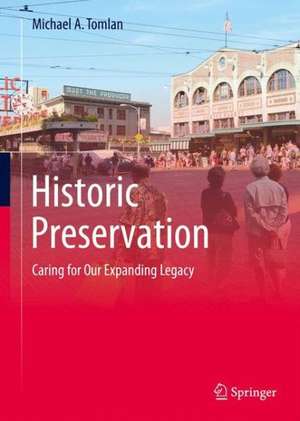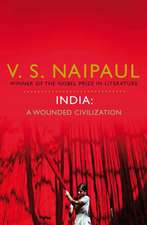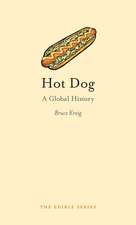Historic Preservation: Caring for Our Expanding Legacy
Autor Michael A. Tomlanen Limba Engleză Hardback – 5 dec 2014
The major topics are introduced in an historical review through the mid-1980s, after which the broad intellectual basis and fundamental legal framework is provided. The economic shifts associated with major demographic changes are explored, in tandem with responses ofthe preservation community. A chapter is dedicated to the financial challenges and sources of revenue available in typical preservation projects, and another chapter focuses on the manner in which seeing, recording, and interpreting information provides the context for an appropriate vision for the future. In this regard, it is made clear that not all “green” design alternatives are preservation-sensitive. The advocacy battles during the last few decades provide a number of short stories of the ethical battles regarding below-ground and above ground historic resources, and the eighth chapter attempts to explain why religion has been long held at arm’s length in publicly-supported preservation efforts, when in fact, it holds more potential to regenerate existing sites than any governmental program.
| Toate formatele și edițiile | Preț | Express |
|---|---|---|
| Paperback (1) | 910.85 lei 6-8 săpt. | |
| Springer International Publishing – 10 sep 2016 | 910.85 lei 6-8 săpt. | |
| Hardback (1) | 963.15 lei 6-8 săpt. | |
| Springer International Publishing – 5 dec 2014 | 963.15 lei 6-8 săpt. |
Preț: 963.15 lei
Preț vechi: 1133.12 lei
-15% Nou
Puncte Express: 1445
Preț estimativ în valută:
184.32€ • 190.41$ • 153.40£
184.32€ • 190.41$ • 153.40£
Carte tipărită la comandă
Livrare economică 26 martie-09 aprilie
Preluare comenzi: 021 569.72.76
Specificații
ISBN-13: 9783319049748
ISBN-10: 3319049747
Pagini: 300
Ilustrații: XXXVII, 383 p. 153 illus., 54 illus. in color.
Dimensiuni: 178 x 254 x 30 mm
Greutate: 9.37 kg
Ediția:2015
Editura: Springer International Publishing
Colecția Springer
Locul publicării:Cham, Switzerland
ISBN-10: 3319049747
Pagini: 300
Ilustrații: XXXVII, 383 p. 153 illus., 54 illus. in color.
Dimensiuni: 178 x 254 x 30 mm
Greutate: 9.37 kg
Ediția:2015
Editura: Springer International Publishing
Colecția Springer
Locul publicării:Cham, Switzerland
Public țintă
GraduateCuprins
Introduction.- Chapter 1: Our changing Need to Preserve.- Chapter 2: The Struggle Continues.- Chapter 3: The Legal Framework.- Chapter 4: Changing Our Economic Outlook.- Chapter 5: Meeting the Financial Challenges.- Chapter 6: Documentation, Context, and Design.- Chapter 7: Advocacy and Ethics.- Chapter 8: Placing Greater Faith in Religion.- Conclusion.
Notă biografică
Michael A. Tomlan is the Director of the Graduate Program in Historic Preservation Planning in the College of Architecture, Art and Planning at Cornell University. With nearly four decades of teaching and field experience, Professor Tomlan serves students pursuing degrees not only in historic preservation but also in archaeology, architecture, city & regional planning, history, public administration, real estate, and urban studies. A published author with a wide range of interests, he also edited Preservation of What? For Whom? A Critical Look at Historical Significance (1998). He currently serves as a Project Director for the National Council for Preservation Education, having established a cooperative agreement for that organization with the National Park Service in 1995 that supports the longest-running preservation internship program in the country. Dr. Tomlan is a Fellow of the Association for Preservation Technology, a former board member of the Society of Architectural Historians, former consultant to the World Monuments Fund and advisor to the Global Heritage Fund, working on significant sites in India, China and Cambodia. He regularly travels abroad as the Treasurer of Heritage Watch International, based in Siem Reap, and the President of Yosothor, a publishing firm in Phnom Penh, in Cambodia. He also remains the Chair of the New York State Barn Alliance, and the President of Historic Urban Plans, Inc., based in Ithaca, NY.
Textul de pe ultima copertă
This well-illustrated book offers an up-to-date synthesis of the field of historic preservation, cast as a social campaign concerned with the condition, treatment and use of the legacy of existing properties in the United States. Drawing on a wide range of research, experience and scholarship over the last fifty years, it allows us to re-think past and current ideas in preservation, challenging readers to explore how their own interests lie within the cognitive framework of the activities taking place with people who care. “Who” is involved is explored first, in such a way as to explore “why”, before examining “what” is deemed important. After that the questions of “when” and “how” to proceed are given attention.
The major topics are introduced in an historical review through the mid-1980s, after which the broad intellectual basis and fundamental legal framework is provided. The economic shifts associated with major demographic changes are explored, in tandem with responses of the preservation community. A chapter is dedicated to the financial challenges and sources of revenue available in typical preservation projects, and another chapter focuses on the manner in which seeing, recording, and interpreting information provides the context for an appropriate vision for the future. In this regard, it is made clear that not all “green” design alternatives are preservation-sensitive. The advocacy battles during the last few decades provide a number of short stories of the ethical battles regarding below-ground and above ground historic resources, and the eighth chapter attempts to explain why religion has been long held at arm’s length in publicly-supported preservation efforts, when in fact, it holds more potential to regenerate existing sites than any governmental program.
The major topics are introduced in an historical review through the mid-1980s, after which the broad intellectual basis and fundamental legal framework is provided. The economic shifts associated with major demographic changes are explored, in tandem with responses of the preservation community. A chapter is dedicated to the financial challenges and sources of revenue available in typical preservation projects, and another chapter focuses on the manner in which seeing, recording, and interpreting information provides the context for an appropriate vision for the future. In this regard, it is made clear that not all “green” design alternatives are preservation-sensitive. The advocacy battles during the last few decades provide a number of short stories of the ethical battles regarding below-ground and above ground historic resources, and the eighth chapter attempts to explain why religion has been long held at arm’s length in publicly-supported preservation efforts, when in fact, it holds more potential to regenerate existing sites than any governmental program.
Caracteristici
Provides a current picture of historic preservation Explores topics such as preservation economics and finance, ethics and advocacy and religious activities Displays the accomplishments of preservation projects throughout the country Includes supplementary material: sn.pub/extras













